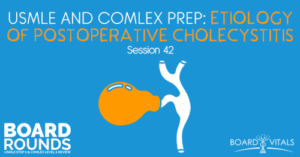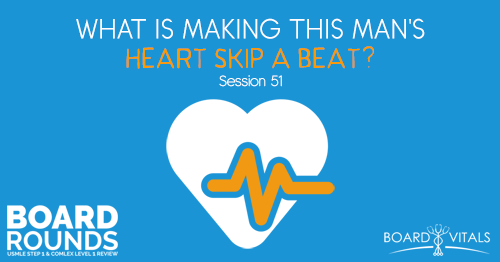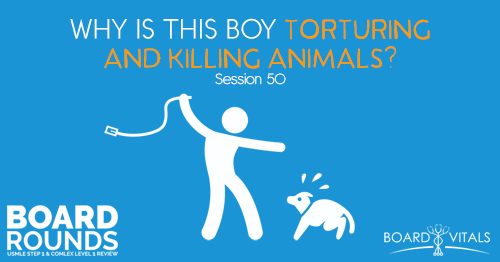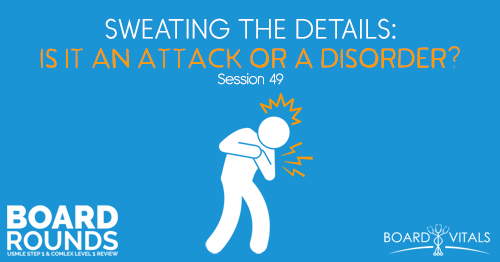Apple Podcasts | Google Podcasts

Session 42
A 46-y/o female has RUQ pain and distension following the surgical repair of a splenic laceration. Which process most likely resulted in her current condition?
As always, I’m joined by Dr. Mike Natter from BoardVitals. If you’re looking for some help with your Step 1 or Level 1, check out BoardVitals. Use the promo code BOARDROUNDS to save 15% off any of their packages.
Also, be sure to check out all our podcasts on Meded Media for more premed and medical school resources.
Listen to this podcast episode with the player above, or keep reading for the highlights and takeaway points.
[03:23] Question of the Week
A 46-year-old woman is admitted to the ICU (intensive care unit) after undergoing an emergency abdominal surgery for repair of a splenic laceration that she sustained in a motor vehicle accident.
Her hospital course has been complicated by posthemorrhagic anemia which requires a transfusion of seven units of packed red cells and hypotension requiring norepinephrine.
Four days after admission, the patient complains of right upper quadrant pain and distention. She is currently afebrile with a pulse of 98 per minute and blood pressure of 105/70. Physical exam indicates right upper quadrant distention and tenderness to palpation.
There is no hepatomegaly. Bedside ultrasound is performed and shows a gall bladder with distention but without gall stones.
Which of the following process most likely resulted in her current condition?
(A) Gallstone impaction in the cystic duct
(B) Hepatic vein thrombosis
(C) Biliary dyskinesia
(D) Cholysystocholic fistula formation
(E) Gallbladder stasis
[04:35] Thought Process
The correct answer here is E. The condition is actually called acute acalculous cholecystitis. Acute means it happened recently, so it’s not chronic. By acalculous, anytime something starts with “a” means the absence of. Calculous is also a stone. So it means a lack of stone. And cholecystitis is the inflammation of the gall bladder sac itself.
We have here a very acutely ill woman who underwent surgery of what sounds like half of her blood volume. She’s a very sick individual.
Very commonly, folks who are very sick in the ICU, especially those who have undergone surgery, are very prone to acalculous cholecystitis.
The ultrasound shows no stone. So we’ve already ruled out all the things about stones.
[09:29] Understanding the Wrong Answer Choices
The hepatic vein thrombosis is also called the Budd-Chiari syndrome. This is common in folks that are hyper or pro coagulable. They’ll have issues with their liver which can get as bad as liver failure. But you typically don’t see gall bladder distention or issues when you have a clot in that area.
So while this is an interesting and highly tested topic of the Budd-Chiari syndrome, this has nothing to do with someone who has acute acalculous cholecystitis.
Let’s take a look at biliary dyskinesia. Dys means dysfunction and kinesia is movement. So it would be an abnormal movement. And in your GI tract, there’s peristalsis. And there’s a peristaltic type of movement in the gall bladder after you eat. One of the hormones that help the secretion of bile from the gall bladder is cholecystokinin.
Folks with biliary dyskinesia are going to have bouts of pain in the right upper quadrant that is related to meals. So this doesn’t line up what the stem was telling us.
For fistula formation, the fistula is an abnormal communication between two lumens in the body. The biliary tree is supposed to be squirting its contents into the duodenum. It should not be having any communication with any part of the bowels.
It happens on occasion if you have a stone in the cystic ducts or one of the ducts of the biliary tree. It can erode into and create a false passage of fistula into any part of the bowels. Once again since there was no evidence of stone, it’s very unlikely that this is the case.
[12:40] The 4 F’s
The four F’s are fat, forty, female, and fertile. Usually, women who are overweight and in their 40’s, and still at a childbearing age will present this right, upper quadrant pain. And usually, there’s something wrong with the gall bladder.
Links:
BoardVitals (promo code BOARDROUNDS and save 15% off)
SEARCH SITE
LISTEN FOR FREE











